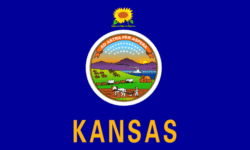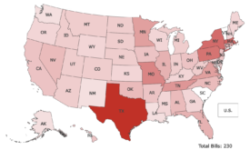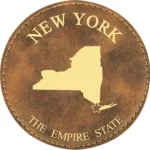 Kansas Attorney General Kris Kobach recently issued a legal opinion declaring that some cities may publish notices on their own websites despite a state law requiring them to be published in local newspapers.
Kansas Attorney General Kris Kobach recently issued a legal opinion declaring that some cities may publish notices on their own websites despite a state law requiring them to be published in local newspapers.
“Home-rule provisions of the Kansas Constitution … allows cities to exempt themselves from nonuniform acts of the Legislature,” Kobach wrote. “We conclude that a second-class city may exempt itself by charter ordinance. And, once having done so may then choose to publish official city business on its own webpage.”
Municipalities with populations between 2,000 and 15,000 people are considered “cities of the second class” in Kansas.
Connecticut Supreme Court to hear public notice case
 In 2019, the tiny Connecticut borough of Fenwick amended its zoning regulations to limit Airbnb-type temporary rentals of local homes. Two property owners in Fenwick opposed the new regulation so they sued to stop it, arguing the local zoning commission violated the state’s statutory notice requirements. Even though Fenwick published timely, substantively sufficient notice in a local newspaper it had used for decades for that purpose, the trial court found the notice didn’t comply with the state’s public notice law and granted the property owners’ motion for summary judgment.
In 2019, the tiny Connecticut borough of Fenwick amended its zoning regulations to limit Airbnb-type temporary rentals of local homes. Two property owners in Fenwick opposed the new regulation so they sued to stop it, arguing the local zoning commission violated the state’s statutory notice requirements. Even though Fenwick published timely, substantively sufficient notice in a local newspaper it had used for decades for that purpose, the trial court found the notice didn’t comply with the state’s public notice law and granted the property owners’ motion for summary judgment.
Column to close statewide-website business
 About a dozen press associations received a bit of a surprise last week when one of the two major vendors of statewide public-notice websites announced it was “sunsetting” that part of its business. In the release announcing its decision, Column said it was making the change to focus on its public notice platform for publishers, which it says “has grown considerably … (o)ver the past year.”
About a dozen press associations received a bit of a surprise last week when one of the two major vendors of statewide public-notice websites announced it was “sunsetting” that part of its business. In the release announcing its decision, Column said it was making the change to focus on its public notice platform for publishers, which it says “has grown considerably … (o)ver the past year.”
Column is giving its press-association clients plenty of time to migrate to a new service; they have until May 31, 2024, to find a new vendor. The company recommended that its clients transition to the other major statewide public-notice website vendor — the Illinois Press Association — which Column called “the best alternative provider of public notice website hosting.”
Ohio enacts law curtailing newspaper notice
 This story was originally published on Sept. 25 and was updated on Oct. 3. New material is italicized.
This story was originally published on Sept. 25 and was updated on Oct. 3. New material is italicized.
Last month, we reported that through the end of the summer there were no states that had approved legislation significantly altering their public notice laws. We were wrong.
Unbeknownst to most in the newspaper business, two months earlier Ohio Gov. Mike DeWine had signed into law measures buried within the legislature’s 6,198-page budget bill that will bring sweeping changes to the state’s public notice regime. DeWine signed the bill less than a week after it passed both the GOP-dominated state House and Senate by wide margins on June 30.
Public notice picture coming into focus
 With only eight state legislatures still in session the legislative die for 2023 has largely been cast. There’s always a chance that one of those states could still make mischief, but when the calendar turns to Dec. 31 it’s likely we’ll be able to say it was a pretty good year for public notice.
With only eight state legislatures still in session the legislative die for 2023 has largely been cast. There’s always a chance that one of those states could still make mischief, but when the calendar turns to Dec. 31 it’s likely we’ll be able to say it was a pretty good year for public notice.
PNRC has been tracking approximately 230 bills introduced this year that have at least a minimal connection to public notice law. Forty-eight have been signed into law. Of those 48 bills, 13 will probably have a slightly negative effect on government transparency while the impact of about 20 others will be moderately positive. The remainder will have little to no substantive effect.
AG supports newspaper notice in Wyoming lawsuit
 Two municipalities in Wyoming passed nearly identical ordinances in 2021 exempting themselves from state statutes mandating the publication of various notices in their local paper of record. A lawsuit subsequently filed by that paper — Lee Enterprise’s Casper Star-Tribune — seeks to compel the cities of Mills and Bar Nunn to publish those notices within its pages.
Two municipalities in Wyoming passed nearly identical ordinances in 2021 exempting themselves from state statutes mandating the publication of various notices in their local paper of record. A lawsuit subsequently filed by that paper — Lee Enterprise’s Casper Star-Tribune — seeks to compel the cities of Mills and Bar Nunn to publish those notices within its pages.
The Star-Tribune is the official newspaper of Natrona County. Mills and Bar Nunn are small but growing communities within the county.
Last month, the state of Wyoming weighed in on the side of the Star-Tribune. The attorney general’s office filed a brief in the case, arguing the state’s public notice laws are valid and must be followed by both local governments.
Is New York the Wild West of public notice?
 The New York Times reported last month on several incidents in which public officials revoked public notice contracts “in an effort to punish their hometown newspapers for aggressive coverage of local politics.” The story included two recent cases in New York state.
The New York Times reported last month on several incidents in which public officials revoked public notice contracts “in an effort to punish their hometown newspapers for aggressive coverage of local politics.” The story included two recent cases in New York state.
New York isn’t the only place where public officials sometimes seek to retaliate against those they perceive as enemies. But the state’s folkways and traditions, along with its arcane and antiquated public notice statutes, often result in the chaotic administration of the law.
Pennsylvania reporter wins public notice reporting award
 It was bound to happen again.
It was bound to happen again.
Jim Lockwood (pictured on left), a reporter for the Times-Tribune in Scranton, Pa., has been named the 2023 winner of PNRC’s Michael Kramer Public Notice Journalism Award.
The award was announced yesterday as part of the National Newspaper Association Foundation’s 2023 Better Newspaper Editorial Contest. Lockwood previously won the prize in 2015 and came in second place, or tied for second, every year since then except 2022.
The award is given annually to the best reporting that uses public notice as a primary source of information.
Louisiana begins transition to newspaper websites
 Last week, Louisiana became the first state to pass a law that will eventually make newspaper websites the primary platform for public notice. HB-650 requires local governments to post their notices on official newspaper websites beginning in 2027. They’ll also be required to publish print notices describing the subject matter and location of the online notices, but — in a reversal of present custom — the print ads will be free and the online notices will be the ads they pay for.
Last week, Louisiana became the first state to pass a law that will eventually make newspaper websites the primary platform for public notice. HB-650 requires local governments to post their notices on official newspaper websites beginning in 2027. They’ll also be required to publish print notices describing the subject matter and location of the online notices, but — in a reversal of present custom — the print ads will be free and the online notices will be the ads they pay for.
HB-650 passed both houses unanimously and is expected to be signed by Gov. Jon Bel Edwards when it reaches his desk.
Few local governments in South Dakota use state portal to post public information
 Jackson County government officials don’t post public information on the internet.
Jackson County government officials don’t post public information on the internet.
The rural western South Dakota county, which serves roughly 2,800 residents spread over 1,871 square miles, doesn’t have a website.
And it doesn’t intend to, County Auditor Vicki Wilson said.
“It takes more time than we have staff,” she said.
State government offers a potential solution, but Jackson County isn’t using it. Nor are most other South Dakota counties, cities or other local governments.
It’s a website created by the Gov. Kristi Noem administration in 2021 where local governments can voluntarily upload their meeting notices, agendas and minutes, without having to manage their own website.
